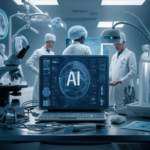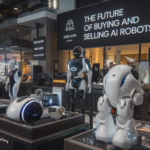Tesla’s Optimus: The Humanoid Robot Poised to Revolutionize Labor and Daily Life
Tesla is well known for its innovations in electric vehicles and autonomous driving technology, but the company is now expanding into a new frontier—humanoid robots. Unveiled at Tesla’s 2021 AI Day event, Optimus, also referred to as the Tesla Bot, represents the company’s bold ambition to revolutionize labor, automation, and even daily tasks at home. With its cutting-edge design and advanced artificial intelligence (AI), Optimus could reshape the way we think about robotics and human-robot interaction.
What Is Tesla’s Optimus?
Optimus is a humanoid robot designed to perform tasks that are dangerous, repetitive, or mundane for humans. Built on Tesla’s powerful AI architecture and leveraging the same technology behind Tesla’s self-driving cars, Optimus aims to assist in everything from manufacturing work to household chores, making it a potentially game-changing innovation in the field of robotics.
The robot Tesla has made is called Optimus, also known as the Tesla Bot. Tesla introduced this humanoid robot at the company’s “AI Day” in August 2021. Optimus is designed to handle tasks that are repetitive, dangerous, or boring for humans, with the long-term goal of helping alleviate labor shortages and performing various jobs in factories and households.
Key Features of Tesla Optimus:
Tesla’s Optimus Gen 2
- Height and Weight: The robot is about 5 feet 8 inches tall (173 cm) and weighs around 125 pounds (57 kg).
- Human-Like Appearance: Optimus has a humanoid form, designed to resemble human proportions, and is intended to move and operate in environments built for people.
- AI and Autonomy: Optimus uses Tesla’s AI technologies, including the software and hardware Tesla developed for its autonomous vehicles, like the Full Self-Driving (FSD) software.
- Dexterity and Mobility: Optimus is built to perform tasks requiring dexterity and balance, such as picking up objects, walking, and using tools. It has a max speed of about 5 miles per hour and can carry up to 45 pounds.
- Applications: Tesla envisions the bot being used for a variety of manual tasks such as assembly line work, moving objects in warehouses, or even performing household chores in the future.
While Optimus is still in development, Tesla’s goal is to mass-produce these robots and make them affordable, potentially having a transformative impact on the future of labor and everyday life.
Human-Like Proportions
Optimus stands 5 feet 8 inches (173 cm) tall and weighs approximately 125 pounds (57 kg), with a sleek, humanoid appearance that mimics the proportions of a human body. Tesla has designed the robot to interact comfortably in human-built environments, whether that be navigating through homes, offices, or factory floors.
AI and Autonomy
The heart of Optimus lies in its AI-driven software. It uses many of the same principles behind Tesla’s Full Self-Driving (FSD) technology, allowing it to perceive its surroundings, make decisions, and execute tasks autonomously. Tesla’s experience with autonomous vehicles, particularly in areas like computer vision and machine learning, forms the foundation of Optimus’ operating system.
Mobility and Dexterity
Optimus is designed for both mobility and precision. It can walk at a speed of up to 5 miles per hour and lift and carry objects weighing up to 45 pounds. Tesla also envisions the robot performing tasks that require a high level of dexterity, such as assembling parts, using tools, and handling delicate objects.
The robot is expected to have human-like hands with actuators that allow for fine motor control, giving it the capability to perform complex operations with precision, such as turning a wrench, tightening bolts, or picking up fragile items.
Safety Features
While robots can sometimes evoke fears of losing control or creating dangerous situations, Tesla has emphasized that Optimus is built with human safety in mind. The robot is programmed to operate at a safe pace and is designed to follow explicit commands from humans. Tesla has assured that Optimus will not pose a threat, as it will be physically weaker than the average person, with built-in safeguards to prevent any potential hazards.
Applications: How Tesla’s Optimus Will Be Used
Tesla envisions multiple applications for Optimus, both in industrial and everyday settings. Here’s how the company expects the robot to transform various aspects of life and work:
Factory Automation
One of the primary use cases for Optimus is in Tesla’s own factories. The robot is expected to perform repetitive tasks like assembling parts on production lines or moving heavy materials around warehouses. By doing so, Optimus could alleviate labor shortages, reduce costs, and improve overall efficiency in manufacturing.
Logistics and Warehousing
Beyond the factory floor, Optimus could play a significant role in logistics and supply chain management. In warehouses, it could assist with sorting, packing, and transporting products. The robot’s AI-powered mobility makes it ideal for managing inventory and even automating last-mile deliveries.
Household Assistance
Tesla also plans to bring Optimus into homes, where it could take on a variety of everyday tasks. Imagine a future where Optimus vacuums, cleans, cooks, or even takes care of your laundry. For elderly or disabled individuals, Optimus could provide critical assistance with activities like getting groceries or helping with personal care.
Labor in Hazardous Environments
Optimus could also be deployed in dangerous environments, such as mining operations or disaster zones, where human workers are at risk. Equipped with sensors and robust AI, the robot could perform tasks in hazardous conditions, minimizing the need for humans to expose themselves to harm.
The Vision for the Future
Tesla’s Optimus is more than just a robot—it’s part of Elon Musk’s larger vision for the future of humanity. Musk has long spoken about the importance of AI in enhancing human life and reducing the drudgery of mundane tasks. He sees robots like Optimus playing a critical role in creating an economy where physical labor is optional, freeing people to focus on more creative and fulfilling pursuits.
By leveraging its advancements in AI and robotics, Tesla aims to push the boundaries of what robots can do, making them more affordable and accessible. Musk has even suggested that in the long term, Optimus could be mass-produced and sold at a price point similar to that of a car, making it feasible for ordinary consumers to have personal robotic assistants.
Market Potential and Impact on the Economy
The potential market for Tesla’s Optimus is vast, spanning industries such as manufacturing, logistics, healthcare, and personal care. Robots like Optimus could significantly reduce labor costs, improve operational efficiency, and address the growing need for automation in an aging global workforce.
Economically, Optimus could create a ripple effect across industries, changing the nature of work. While some jobs, particularly in manual labor, may become obsolete, new roles centered around programming, maintenance, and oversight of these robotic systems could emerge. Tesla’s Optimus could be a key driver of productivity, leading to a shift in the labor market towards more highly skilled jobs.
Challenges and Considerations
While Tesla’s vision for Optimus is revolutionary, the robot still faces significant challenges. Developing a robot that can operate autonomously in a variety of real-world settings is a complex task, especially in terms of ensuring safety, reliability, and adaptability.
Tesla will also need to address ethical and societal concerns around AI and automation. There are growing debates about the impact of AI on employment and the potential for robots to replace human workers. Ensuring that the development of robots like Optimus leads to positive outcomes for society will be a key consideration for Tesla moving forward.
Tesla’s Optimus represents a bold leap into the future of robotics and AI, with the potential to transform both industries and daily life. Whether it’s working alongside humans in factories, assisting with household chores, or taking on dangerous tasks, Optimus could become a versatile and invaluable tool in the coming years.
As Tesla continues to refine the robot’s capabilities and explore its applications, Optimus could well become the next major technological breakthrough, unlocking new possibilities for automation, productivity, and human-robot collaboration. The world will be watching closely as Tesla takes this ambitious step into the realm of humanoid robotics.






